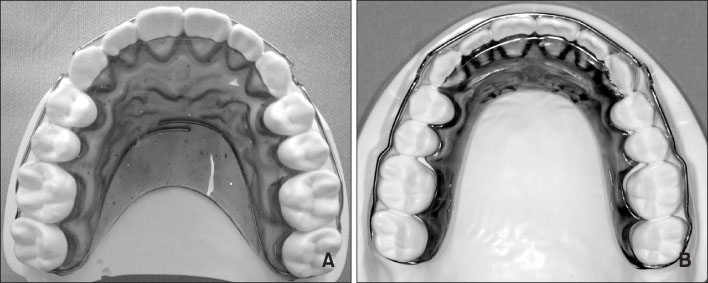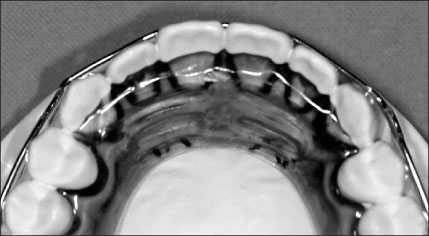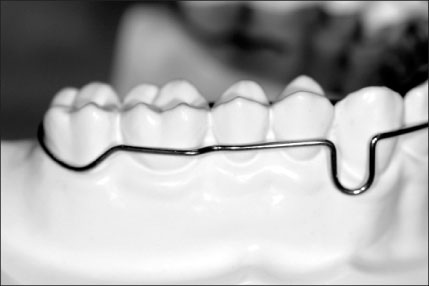Korean J Orthod.
2010 Oct;40(5):325-333. 10.4041/kjod.2010.40.5.325.
Discomfort caused by the circumferential comfortable retainer (CCR) as a removable maxillary retainer
- Affiliations
-
- 1Department of Dentistry, Chung-Ang University College of Medicine, Seoul, Korea. profchoi@cau.ac.kr
- 2Department of Orthodontics, Gachon University Dental Hospital, Seoul, Korea.
- KMID: 2273223
- DOI: http://doi.org/10.4041/kjod.2010.40.5.325
Abstract
OBJECTIVE
The aim of this study was to illustrate the circumferential comfortable retainer (CCR) as a removable maxillary retainer with good potential patient compliance and to evaluate the discomfort of the retainers including distorted speech, gagging sensation and appliance discomfort.
METHODS
Sixty-six orthodontic patients (male, 23; female, 43; mean age, 23.42 +/- 10.19 years) who received orthodontic treatment with fixed orthodontic appliances were randomly assigned to two groups after debonding, a conventional wraparound retainer (CWR) group that fully covers the palate with an acrylic plate and a highly polished surface, and a circumferential comfortable retainer (CCR) group which has a horseshoe shaped base plate with three folds on the anterior region. A questionnaire that had a visual analog scale (VAS) which consists of a 100-mm horizontal line with 2 end-points labeled "no discomfort" on the left and "worst discomfort" on the right, with regard to distorted speech, gagging sensation and discomfort, was administered to patients after 4 weeks of retainer wear. The Mann-Whitney test was used to test the hypothesis that there was no difference between the two retainers.
RESULTS
Comparing distorted speech and discomfort, the CCR group significantly had lower values than the CWR group (p < 0.05). Comparing gagging sensation, the CCR group had lower values than the CWR group but there were no statistically significant differences between groups (p = 0.146).
CONCLUSIONS
In conclusion, the results suggest that the circumferential comfortable retainer (CCR) might facilitate patient compliance and thereby improve the maintenance of the fixed orthodontic treatment outcome.
MeSH Terms
Figure
Reference
-
1. Sheridan JJ. The three keys of retention. J Clin Orthod. 1991. 25:717–724.2. Hwang CJ. Analysis of characteristics of medical accidents and disputes in orthodontic area. Korean J Orthod. 1999. 29:1–22.3. Egolf RJ, BeGole EA, Upshaw HS. Factors associated with orthodontic patient compliance with intraoral elastic and headgear wear. Am J Orthod Dentofacial Orthop. 1990. 97:336–348.
Article4. Oliver RG, Knapman YM. Attitudes to orthodontic treatment. Br J Orthod. 1985. 12:179–188.
Article5. Bartsch A, Witt E, Sahm G, Schneider S. Correlates of objective patient compliance with removable appliance wear. Am J Orthod Dentofacial Orthop. 1993. 104:378–386.
Article6. Brattström V, Ingelsson M, Aberg E. Treatment co-operation in orthodontic patients. Br J Orthod. 1991. 18:37–42.
Article7. Stratton CS, Burkland GA. The effect of maxillary retainers on the clarity of speech. J Clin Orthod. 1993. 27:338–340.8. Moyers RE. Moyers RE, editor. Development of dentition and occlusion. Handbook of orthodontics for the student and general practitioner. 1973. 3rd ed. Chicago, Ill: Year Book Medical Publishers;175–192.9. Bishara SE. Oral lesions caused by an orthodontic retainer: a case report. Am J Orthod Dentofacial Orthop. 1995. 108:115–117.
Article10. Seymour RA, Simpson JM, Charlton JE, Phillips ME. An evaluation of length and end-phrase of visual analogue scales in dental pain. Pain. 1985. 21:177–185.
Article11. Giannopoulou C, Dudic A, Kiliaridis S. Pain discomfort and crevicular fluid changes induced by orthodontic elastic separators in children. J Pain. 2006. 7:367–376.
Article12. Kluemper GT, Hiser DG, Rayens MK, Jay MJ. Efficacy of a wax containing benzocaine in the relief of oral mucosal pain caused by orthodontic appliances. Am J Orthod Dentofacial Orthop. 2002. 122:359–365.
Article13. Bird SE, Williams K, Kula K. Preoperative acetaminophen vs ibuprofen for control of pain after orthodontic separator placement. Am J Orthod Dentofacial Orthop. 2007. 132:504–510.
Article14. Joondeph DR. Graber TM, Vanarsdall RL, Vig KWL, editors. Retention and relapse. Orthodontics: current principles and techniques. 2005. 4th ed. St. Louis, Mo: Elsevier Mosby;1123–1151.15. Mills JR. A long-term assessment of the mechanical retroclination of lower incisors. Angle Orthod. 1967. 37:165–174.16. Moss JP. The soft tissue environment of teeth and jaws. An experimental and clinical study: part 1. Br J Orthod. 1980. 7:127–137.
Article17. Moss JP. The soft tissue environment of teeth and jaws. Experimental malocclusion: Parts 2 and 3. Br J Orthod. 1980. 7:205–216.
Article18. Reitan K. Clinical and histologic observations on tooth movement during and after orthodontic treatment. Am J Orthod. 1967. 53:721–745.
Article19. Gottlieb EL, Nelson AH, Vogels DS 3rd. 1996 JCO study of vorthodontic diagnosis and treatment procedures, Part 1. Results and trends. J Clin Orthod. 1996. 30:615–629.20. Destang DL, Kerr WJ. Maxillary retention: is longer better? Eur J Orthod. 2003. 25:65–69.
Article21. Erb DP. Speech effects of the maxillary retainer. Angle Orthod. 1967. 37:298–303.22. Laine T. Articulatory disorders in speech as related to size of the alveolar arches. Eur J Orthod. 1986. 8:192–197.
Article23. Oliver RG, Evans SP. Tongue size, oral cavity size and speech. Angle Orthod. 1986. 56:234–243.24. Haydar B, Karabulut G, Ozkan S, Aksoy AU, Ciğer S. Effects of retainers on the articulation of speech. Am J Orthod Dentofacial Orthop. 1996. 110:535–540.
Article25. Reinicke C, Obijou N, Tränkmann J. The palatal shape of upper removable appliances. Influence on the tongue position in swallowing. J Orofac Orthop. 1998. 59:202–207.26. Jones ML. An investigation into the initial discomfort caused by placement of an archwire. Eur J Orthod. 1984. 6:48–54.
Article
- Full Text Links
- Actions
-
Cited
- CITED
-
- Close
- Share
- Similar articles
-
- A survey on retention practice among orthodontists in Malaysia
- ANALYSIS OF STRESS DEVELOPED WITHIN THE SUPPORTING TISSUE OF ABUTMENT TOOTH WITH INDIRECT RETAINER ACCORDING TO VARIOUS DESIGNS OF DIRECT RETAINER AND DEGREE OF BONE RESORPTION
- Non-surgical treatment and retention of open bite in adult patients with orthodontic mini-implants
- The Effects Of Tooth Mobility And Design Of Direct Retainer On The Stress Of Supporting Tissues In Unilateral Distal Extension Removable Partial Denture
- Evaluation of clinical status of removable partial dentures







